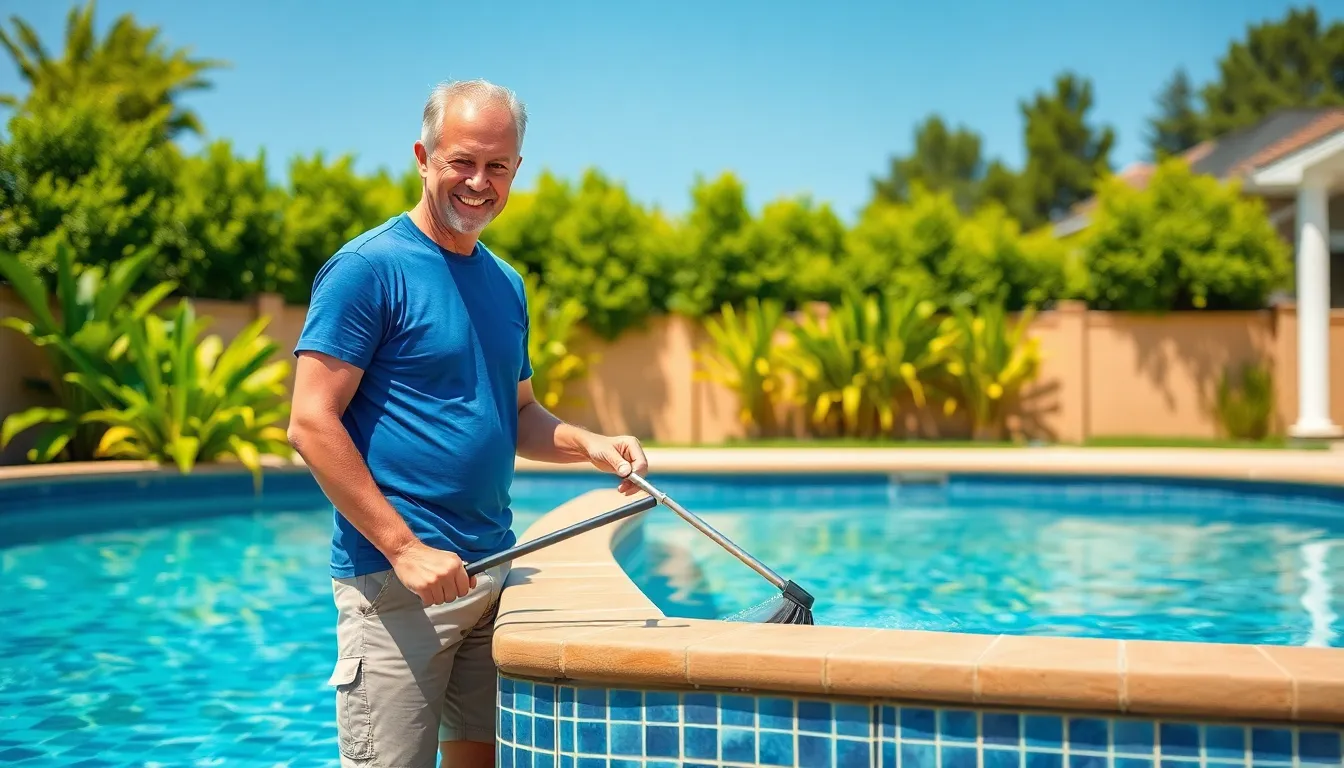Table of Contents
ToggleOwning a pool is like having a backyard paradise—until the reality of maintenance costs hits. Suddenly, that shimmering oasis starts to look more like a financial black hole. But don’t worry, it’s not all doom and gloom. Understanding the average pool maintenance cost can turn your frown upside down and help you dive into budgeting like a pro.
From the regular scrubbing to the occasional surprise repair, knowing what to expect can save both your sanity and your wallet. So grab your floaties and let’s explore the ins and outs of keeping your pool pristine without draining your bank account. After all, who said enjoying summer fun had to come with a hefty price tag?
Understanding Average Pool Maintenance Cost
Average pool maintenance costs typically range from $80 to $150 per month. Monthly expenses encompass routine services such as cleaning, chemical balancing, and equipment inspections. Homeowners may budget between $500 to $1,200 annually for pool maintenance, depending on factors such as pool type, size, and location.
Service frequency impacts overall costs. Weekly cleaning visits generally ensure optimal water quality and cleanliness, while bi-weekly services may reduce maintenance expenses but increase the chances of water quality issues. Seasonal maintenance also affects costs. It can reach up to $300 for initial spring openings and winterization services.
Unexpected repairs can strain budgets. Pool equipment, like pumps and filters, might require replacement or repair at an average cost of $200 to $1,000. Structural issues such as cracks may lead to expenses ranging from $500 to $3,000. It’s advisable to allocate a contingency fund for these unforeseen repairs.
Geographic location plays a significant role in determining costs. Areas with a higher cost of living generally experience increased maintenance fees. Additionally, climate influences maintenance demand; warmer regions may require more frequent servicing.
By understanding these average pool maintenance costs, homeowners can make informed decisions. Prioritizing regular upkeep prevents costly repairs down the line. Allocating budgets effectively allows for a summer filled with enjoyment and peace of mind, ensuring that pool ownership remains a rewarding experience.
Factors Affecting Pool Maintenance Cost

Multiple factors influence the costs associated with maintaining a pool. Understanding these influences helps homeowners plan effectively for expenses.
Pool Size and Type
Pool size significantly affects maintenance costs. Larger pools require more chemicals, more time for cleaning, and higher utility costs. In-ground pools, unlike above-ground options, typically incur higher maintenance expenses due to their complex systems and structural materials. Different types of pools, such as saltwater or chlorine pools, also differ in upkeep costs. Saltwater pools often demand lower chemical expenses but incur higher initial setup costs. Specific maintenance needs arise based on the pool’s construction and the materials used, impacting overall financial commitments.
Location and Seasonal Changes
Location plays a critical role in pool maintenance expenses. Areas with harsh climates often see higher costs due to more frequent cleaning and repairs. Seasonal changes affect budget allocations for maintenance, with spring openings and fall winterization adding costs typically around $300. Regions that experience heavy rainfall or debris accumulation require more frequent cleaning, further driving up expenses. Homeowners should account for these location-specific factors when planning their annual maintenance budgets. Understanding local climate trends prepares them for seasonal variations in upkeep costs.
Breakdown of Average Pool Maintenance Expenses
Understanding the breakdown of pool maintenance expenses helps homeowners manage their budgets effectively. Costs vary based on several factors, making it important to analyze specific categories.
Cleaning Supplies and Equipment
Cleaning supplies and equipment form a significant part of pool maintenance costs. Homeowners typically spend between $20 and $50 per month on items like nets, brushes, and vacuums. Investing in quality equipment can lead to savings over time as it often withstands more wear. Routine upkeep, including skimming debris and brushing walls, ensures optimal water clarity. Some pool owners opt for automatic cleaners, which can range from $200 to $1,500 initially but offer long-term convenience. Regular inspections of these tools can help reduce unexpected replacement costs, maintaining budget control.
Chemicals and Water Testing
Chemicals and water testing expenses are critical for proper pool upkeep. Average monthly costs for pool chemicals range from $30 to $100, depending on water balance needs and pool type. Chlorine pools generally require more frequent chemical applications. Saltwater pools incur lower chemical costs but require salt cell maintenance. Testing kits for monitoring water conditions also contribute to expenses, with prices ranging from $15 to $100. Regular water testing ensures safe swimming conditions and allows homeowners to adjust chemical levels proactively, preventing costly imbalances.
Professional Services vs. DIY
Hiring professional pool maintenance services incurs regular costs that impact monthly budgets. Monthly expenses typically range from $80 to $150 for routine care, including cleaning and chemical balancing. Frequent service, particularly weekly visits, ensures optimal water quality, reducing the risk of expensive repairs. Seasonal openings and winterization add to annual costs, totaling around $300 in some cases.
Diving into the DIY approach offers a cost-effective alternative. Homeowners can save on labor fees by handling tasks like cleaning and chemical testing themselves. Expenses for DIY maintenance average $20 to $50 monthly for cleaning supplies, while chemical costs range from $30 to $100, contingent on pool type.
Understanding the implications of each option is crucial. While DIY maintenance may offer savings, professional services provide expertise and efficiency. Factors that influence the decision include pool size, type, and climate. Larger or in-ground pools may require more specialized knowledge or equipment that can strain a DIY budget. Harsh climates might necessitate more frequent service, tipping the balance in favor of professionals.
Evaluating personal comfort levels with various maintenance tasks also plays a role. Some homeowners might lack confidence in their ability to maintain pool water chemistry correctly. In such scenarios, investing in professional services ensures safety and peace of mind.
Ultimately, the choice between professional services and DIY hinges on individual needs and circumstances. Balancing cost, convenience, and pool condition determines the best approach for maintaining a healthy and enjoyable swimming experience.
Tips for Reducing Pool Maintenance Costs
Reducing pool maintenance costs requires strategic planning and conscious decisions. One effective approach is to establish a regular maintenance schedule.
Regular Maintenance Schedule
Routine maintenance not only prolongs a pool’s lifespan but also prevents costly repairs. Weekly cleaning ensures consistent water quality and clarity. It typically falls within $80 to $150 per month for professional services. Homeowners can opt for DIY methods, significantly lowering monthly expenses to $50 to $100. Covers include skimming debris, brushing surfaces, and testing water chemistry. The financial benefit becomes evident as regular upkeep minimizes the risk of larger unforeseen costs.
Energy-Efficient Equipment
Investing in energy-efficient equipment yields long-term savings on utility bills. Variable-speed pumps use less electricity compared to single-speed models and can reduce energy costs by up to 70%. Energy-efficient heaters also contribute to lower monthly expenses. In addition, LED lighting enhances pool aesthetics while keeping energy use minimal. Pool owners should consider options that carry the ENERGY STAR label for assured savings. These investments ultimately reflect positive impacts on both maintenance costs and environmental sustainability.
Understanding average pool maintenance costs is essential for any pool owner. By recognizing the typical expenses and factors that influence them, homeowners can make informed decisions about their maintenance strategies. Regular upkeep not only enhances the pool experience but also helps prevent unexpected financial burdens.
Whether opting for professional services or a DIY approach, prioritizing maintenance can lead to long-term savings and enjoyment. With careful planning and consideration of factors like pool type and location, maintaining a pool can be a manageable and rewarding endeavor. Embracing these insights allows for a more enjoyable and financially sustainable pool ownership journey.




